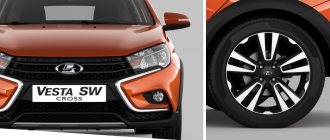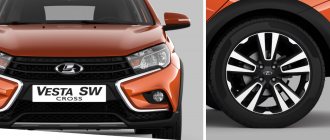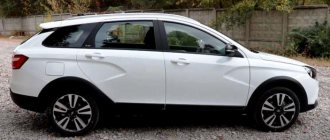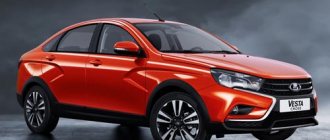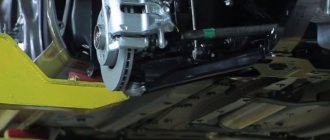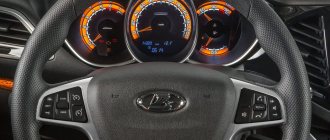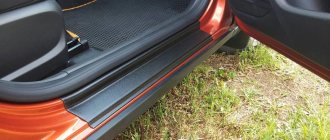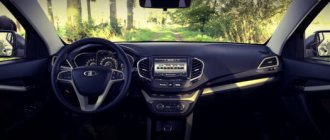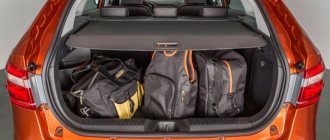June 28, 2017 Lada.Online 13 288 4
After AVTOVAZ showed the production versions of the Lada Vesta station wagons (regular and cross), Autoreview correspondents already managed to look at them with their own eyes. In their review, they talk about the most important things: appearance, engine, transmission, trunk and modifications that they will receive..
The serial Lada Vesta station wagon is almost identical to the 2015 concept car. Initially, AVTOVAZ considered two options: more practical or more stylish. There is already a Lada Largus to transport cargo, so it was decided to make the new station wagon fashionable first and foremost.
LADA Vesta SW. More space to live
Cars with a body type “SW” are aimed at active recreation and long trips. Therefore, there is increased space for passengers and many storage niches are provided. And this car is truly beautiful - after all, all members of its family should like it!
Friend, helper, family man
Galvanizing methods
Today, galvanizing the roof or the entire car body is done using four technologies. The differences lie in the cost and quality of the waterproof protection. One method can be used exclusively in the budget segment of cars from manufacturers aimed at the mass market, while the other involves high-quality processing of the body of premium cars.
Hot galvanized
At the factory, molten zinc is poured into the bath, heated to temperatures of 460-500°C. After this, the fully assembled car body is dipped into this liquid, allowing it to adhere to the surface with a layer 13-15 microns thick.
Heat treatment provides the zinc coating with a service life of up to 15 years, and also takes the brunt of damage from corrosion. When the paintwork is mechanically damaged, rust begins to eat the zinc layer, but not the body material itself.
Body protection. Photo source: https://club-vesta.ru/ustrojstvo/zashhita-kuzova-lada-vesta-i-iks-rej-otsinkovka-grunt-ispytaniya
The disadvantages of hot technology include its high price, which is why it is used only in the production of expensive cars of the luxury, premium and business classes.
Galvanic galvanization
The advantage of the galvanic method is the uniform distribution of the zinc-containing layer over the entire surface of the car body. For this purpose, an electrolyte containing a waterproof non-ferrous metal is used.
Body protection for Lada Vesta. Photo source: https://club-vesta.ru/ustrojstvo/zashhita-kuzova-lada-vesta-i-iks-rej-otsinkovka-grunt-ispytaniya
As with thermal technology, with galvanic technology the body is lowered into a bath of liquid, where zinc particles are deposited on the body under the influence of an electric current. Compared to the hot method, the galvanic method is cheaper and provides up to 10 years of service life of the protective layer for the metal of the machine.
Cold galvanizing
The cold galvanizing procedure involves coating the car body with primer, which includes highly dispersed zinc powder. The result is a car with a relatively low degree of corrosion protection, but at a noticeably lower cost.
Cold galvanizing. Photo source: https://topofyoutube.ru/images/9919482
The main disadvantage of the method lies in the fact that even minor mechanical damage to the body, violating the integrity of the soil layer, makes it vulnerable to rust formation. Also, the disadvantages include the difficulty of galvanizing car bodies with a non-standard design, which can result in the formation of areas with uneven coating thickness. At the moment, the manufacturer AvtoVAZ galvanizes the Lada Vesta SV using this technology to save money and ensure a minimum level of water resistance of the body.
Zinc metal
The only zinc processing technology in which a protective coating is applied at the metal rolling stage. The car body is assembled with two waterproof layers on it. A fairly cheap method of coating a car with zinc, which is often used by manufacturers of inexpensive cars in the economy segment.
Vesta body frame. Photo source: https://club-vesta.ru/ustrojstvo/zashhita-kuzova-lada-vesta-i-iks-rej-otsinkovka-grunt-ispytaniya
The main disadvantage of zinc metal is the low resistance of the layers to mechanical damage and not the highest level of protection against rust formation.
Multimedia system
A multimedia system with a 7-inch screen offers your favorite music, radio news, and hands-free telephone communication. Everything you need to make your trip faster and more enjoyable! And the navigator will make travel not only faster, but also easier and more efficient. The image from the rear view camera is displayed on the multimedia screen - together with parking sensors, this ensures confident maneuvering in cramped cities.
Myths about galvanizing
Despite the fact that galvanizing technology has been used in the automotive industry for decades, there are still many misconceptions associated with it.
Factory applied zinc layer guarantees complete rust protection
Only premium and luxury car coatings can boast a high level of corrosion resistance. The main task of galvanizing for more affordable cars is to protect the most vulnerable areas of the body - its outer side, areas with welded seams and thresholds.
No additional anticorrosive treatment is required for galvanizing.
Not all zinc coating technologies ensure uniform distribution of the protective layer over the body. Therefore, it is recommended to take care of additional surface treatment with anti-corrosion agent.
Self-treatment with anti-corrosion aerosol can replace the factory
Without specialized education and special equipment, the user can only extend the life of the current anti-corrosion coating and patch up chipped areas.
Engines
LADA Vesta is an opportunity to choose a power unit in accordance with your individual driving style and dynamics needs. 1.6l + “mechanics” is an economical option. 1.8l + “mechanics” - a solid supply of traction! 1.6L + automatic transmission – smooth movement and confident acceleration! Well, special chassis settings provide comfort and exciting handling.
Displacement 1596 cm Power 106 hp (78 kW) at 5800 rpm Torque 148 Nm at 4200 rpm Emission standards EURO-5
Displacement 1774 cm Power 122 hp (90 kW) at 5900 rpm Torque 170 Nm at 3700 rpm Emission standards EURO-5
Displacement 1598 cm Power 113 hp (83 kW) at 5500 rpm Torque torque 152 Nm at 4000 rpm Emission standards EURO-5
Any LADA Vesta model can now become even brighter, more contrasting and stylish. Simply order the optional roof and door mirrors in high-gloss black. Which combination looks better? Black and red? Black and blue? Or maybe black and orange? The choice is yours! The black roof is used in conjunction with the entire palette of LADA Vesta enamels, excluding “Maestro” and “Phantom”.
Coating thickness
Depending on the galvanizing technology used, the car body may have a different thickness of the waterproof layer. With the hot galvanizing method, the car receives a coating of 12-15 microns. Galvanic treatment provides the body with a layer thickness of 5 to 10 microns. A similar value is obtained with the cold method of applying zinc. An exception is zinc metal technology, in which the body is assembled from processed material. Therefore, the thickness of the zinc layer can be from 12 to 25 microns on top of the steel body.
LADA Vesta SW configurations and prices
| Safety | Add a package
| Add a package
|
| Driver airbag | |
| Front passenger airbag with deactivation function | |
| Rear seat headrests 3 pcs. | |
| ISOFIX child seat anchors | |
| Automatic door locking when driving | |
| Immobilizer | |
| Daytime Running Lights | |
| Anti-lock braking system with brake assist system (ABS+BAS) | |
| Electronic Brake Force Distribution (EBD) | |
| Electronic Stability Control (ESC) | |
| Traction Control System (TCS) | |
| Hill start assist system HSA) | |
| Engine and engine compartment protection | |
| Locking the rear doors against opening by children | |
| Automatic activation of the hazard warning lights during emergency braking | |
| Automatic door unlocking and hazard warning lights in the event of a collision | |
| Security alarm | |
| Fog lights | |
| Emergency warning system ERA-GLONASS | |
| Rear disc brakes | |
| Side airbags |
| Interior | Add a package
| Add a package
|
| On-board computer | |
| Gear shift prompt in the instrument cluster | |
| Central armrest with box | |
| 60/40 split folding rear seat | |
| Interior (optional) Mouton gray/Sandal brown | |
| Driver and passenger sun visor with mirror | |
| Case for glasses | |
| 12V socket | |
| Interior (optional) Anthracite black/Sandal brown | |
| Rear armrest |
| Comfort | Add a package
| Add a package
|
| Electric power steering | |
| Height and reach adjustable steering column | |
| Adjusting the height of the front seat belts | |
| Driver's seat with height adjustment and lumbar support | |
| Cabin air filter | |
| Light window tinting | |
| Folding key | |
| Central locking with remote control | |
| Power windows for front doors | |
| Power windows for rear doors | |
| Heated front seats 3 levels | |
| Electric drive and heated exterior mirrors | |
| Rear parking sensors | |
| Air conditioner | |
| Cooled glove box | |
| Cruise control and speed limiter | |
| Multifunction steering wheel | |
| Audio system (4.3" monochrome display, FM/AM with RDS function, USB, SD card, AUX, Bluetooth, Hands free), 4 speakers | |
| Exterior mirrors with side direction indicators | |
| Heated windshield | |
| Rain and light sensors | |
| Climate control | |
| Rear View Camera | |
| Multimedia system with navigation (7" color display with TouchScreen, FM/AM with RDS function, USB, SD card, AUX, Bluetooth, Hands free), 6 speakers | |
| Reinforced tinted rear windows | |
| Heated rear seats |
| Exterior | Add a package
| Add a package
|
| Railings | |
| Spoiler | |
| Decorative wheel caps | |
| Exterior mirrors and exterior door handles in body color | |
| 16" alloy wheels | |
| Spare steel wheel for temporary use 15" |
How else to protect the body
The galvanizing procedure alone is not enough to ensure durability of the car body in conditions of contact with moisture. If the outer side of the body is treated with non-ferrous metal, then the internal parts are coated with a primer using cataphoresis. Cataphoresis, as a method of applying primer, is similar to galvanic galvanizing technology and also involves lowering the body into a bath of solution.
Body frame. Photo source: https://www.drive2.com/l/510911993297764839/
Also, as a measure of additional protection against scratches and moisture, it is popular to cover the car with an anti-gravel laminating film over the paintwork.
Technical characteristics of Lada Vesta SV
| Body | Add a package
| Add a package
|
| Engine location | |
| Length / width / height, mm | |
| Base, mm | |
| Ground clearance, mm | |
| Luggage compartment volume in passenger/cargo… | |
| Wheel formula / drive... | |
| Body type / quantity... | |
| Number of seats | |
| Front/rear wheel track,… |
| Engine | Add a package
| Add a package
|
| engine's type | |
| Supply system | |
| Working volume, cubic meters cm | |
| Fuel | |
| Engine code | |
| Quantity, location... | |
| Maximum power, kW (hp) / rev…. | |
| Maximum torque, Nm / rev…. |
| Dynamic characteristics | Add a package
| Add a package
|
| Maximum speed, km/h | |
| Acceleration time 0-100 km/h, s |
| Fuel consumption | Add a package
| Add a package
|
| Urban cycle, l/100 km | |
| Extra-urban cycle, l/100 km | |
| Combined cycle, l/100 km |
| Weight | Add a package
| Add a package
|
| Curb weight, kg | |
| Fuel tank volume, l | |
| Technically permissible maximum weight... | |
| Maximum trailer weight without brake system /… |
| Transmission | Add a package
| Add a package
|
| Transmission type | |
| Main gear ratio... |
| Suspension | Add a package
| Add a package
|
| Front | |
| Rear |
| Steering | Add a package
| Add a package
|
| Steering gear |
| Tires | Add a package
| Add a package
|
| Dimension |
Exterior
Initially, Lada Kalina was considered exclusively as a “workhorse”. Consequently, the attitude towards design was largely characterized by the residual principle. They say that this is not the main thing for such a machine. But after the restyling, the model began to look much more lively and aggressive.
Initially, the Lada Kalina was a simple car. Rather, even too simple.
The front bumper is decorated with a huge air intake supporting a small radiator grille. And under the spectacular headlights there are small foglights located in massive seats.
The new Kalina looks much more interesting from the front!
However, there are an order of magnitude fewer changes in the profile. The same modest and proportional doors, a round tank flap with a recess for opening, front fenders and so on. Perhaps the changes affected only the rims and rear fenders.
On the side, other than the different rear wings and rims, no changes are observed.
The situation is similar with regard to the stern. There are no fundamental changes observed, with the exception of the rear bumper, which has become more massive and powerful, and has also acquired new reflectors and a trim at the bottom.
At the rear, the changes are more noticeable, but they are not fundamental.
The image of Lada Vesta is fundamentally different. She was not a nondescript machine, to which they later tried to instill pseudo-aggressive features. Initially, Lada Vesta was created as a landmark and expressive car - the first representative of AvtoVAZ’s new corporate style. That’s why it looks more harmonious – the headlights, chrome, air intake, foglights, “X” lines and other elements of the front end combine perfectly.
Vesta's front end is much more harmonious.
From the side the impression is the same. A solid, complete product, with logical lines and transitions, stylish rims and considerable ground clearance.
The ground clearance of the Lada Vesta can be the envy of some crossovers.
And the food didn’t disappoint. The chopped lines of the stops are impressive, especially against the background of a modest bumper and a proportional trunk lid, decorated with large letters of the brand name.
Vesta looks great from behind!
